Early-warning Systems to Prevent Fires in Urban Slums
Paul Mesarcik (Lumkani)
- Fire spreads quickly, houses are fragile to fire and extremely dense in those urban slums
- In March 2015 in Manila, just 2 fires made 10,000 families go homeless
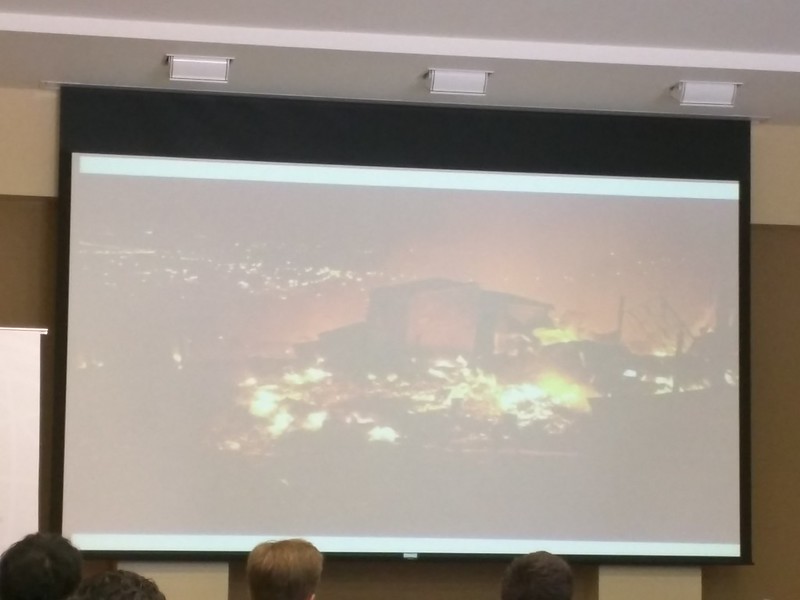
Solution:
1. In-home heat detector
2. Transmission to neighbouring devices
3. Data collection through internet gateway
2007 - 1 billion people worldwide were affected
2020 - 1.4 billion people worldwide will be affected
Urban slums are one of the most underserved communities in the world.
Peer to Peer Communication for Resilience
Meena Palaniappan (Atma Connect)
- Connecting and empowering people for resilience
- People are not objects of development, we need to work together
- Poor people will suffer the most from climate changes- flooding, etc
- Social cohesion is key resilience tool (people are far more likely to survive disasters when they have good social networks and connections)
- Mobiles for people- build technology to help people solve their own problems.
- AtmaGo - a mobile web app to connect and help neighbors
- People in poor neighborhoods miss early warnings. Hyper local information sharing is important, with information such as flood is coming, road blocks, etc.
- AtmaGo is built on Facebook and Twitter, since that's what people in Jakarta use.
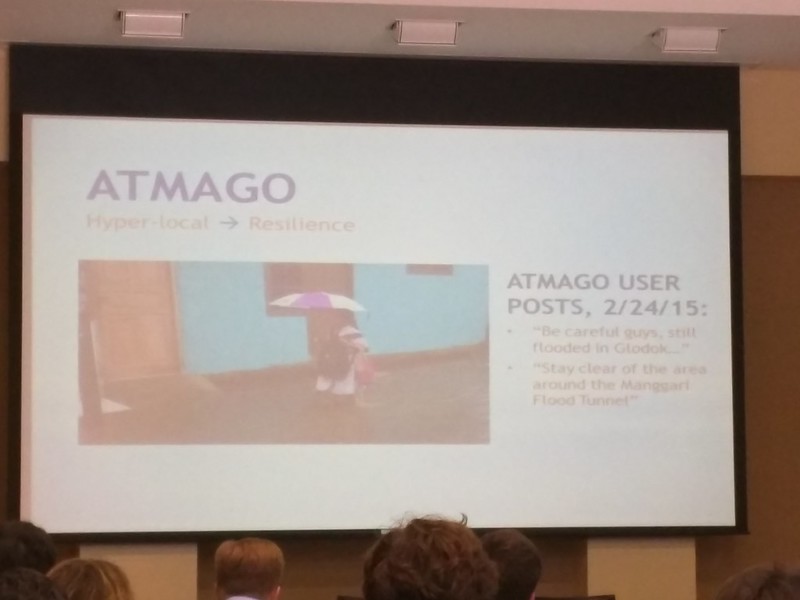
Data Mining to Increase Small Farmer Resilience & Agricultural Performance in Latin America
Everett Wetchler (Bayes Impact)
- Agriculture yields problem- focus on rice
- Growing global competition, climate change, FTA making farmers difficult
- Organizations in LatAm- many are funded internationally
- Big data in rice agriculture workshop - many talented agronomists, very few software engineers
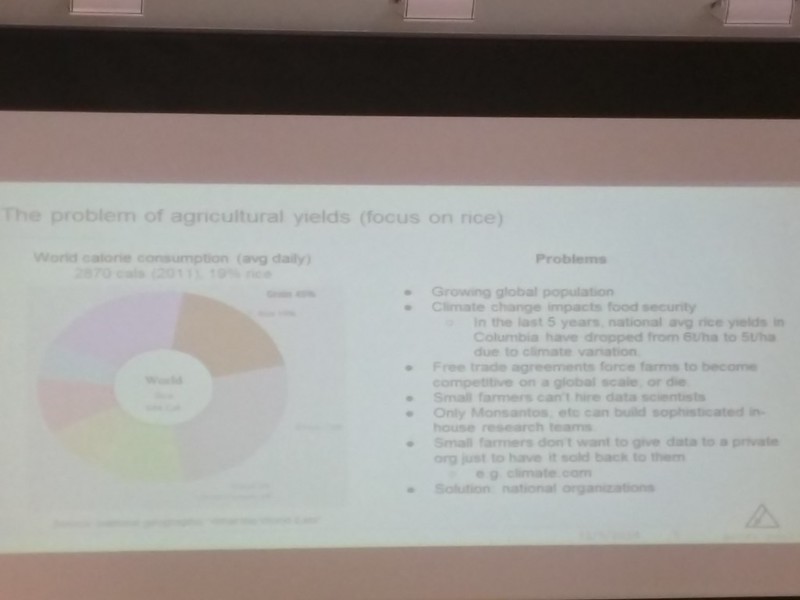
Finding Data Invisibles: Addressing the Data Gap with Callboxes
Rose Shuman & Mita Paramita (QuestionBox)
- BrightFront Group
- National Ebola Hotline for UNICEF
- QuestionBox infrastructure is free public community for central hotline in local language
- Featured in World Economic Forum as data-driven development
- Community based reciprocity
- Putting QuestionBox in health clinics
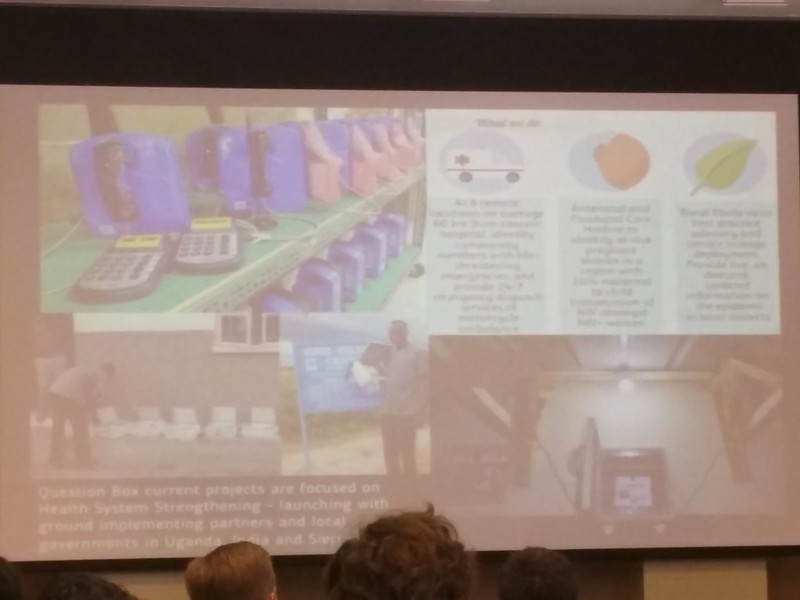
3 Modes of resilience
1) direct linkages 2) self-sufficiency 3) short term infrastructure
Crowdsourcing Community Resilience Solutions in Dhaka
Ian O’Donnell (Red Cross)
- Safer, healthier and stronger communities
- Designing across Red Cross Red Crescent Network: 189 countries, 60k local branches, 17 million volunteers
- Engaging one billion people for safety and resilience by 2025
- Enabling local problem solving at scale
-RedCross, Governmental networks, academic and NGOs, business networks
- Making city coalitions
- Working with urban slum in Dhaka. Not a lot of information sharing
- Working with Open Streetmap, Tech Hubs, utilization of mobile data, working with World Bank, etc
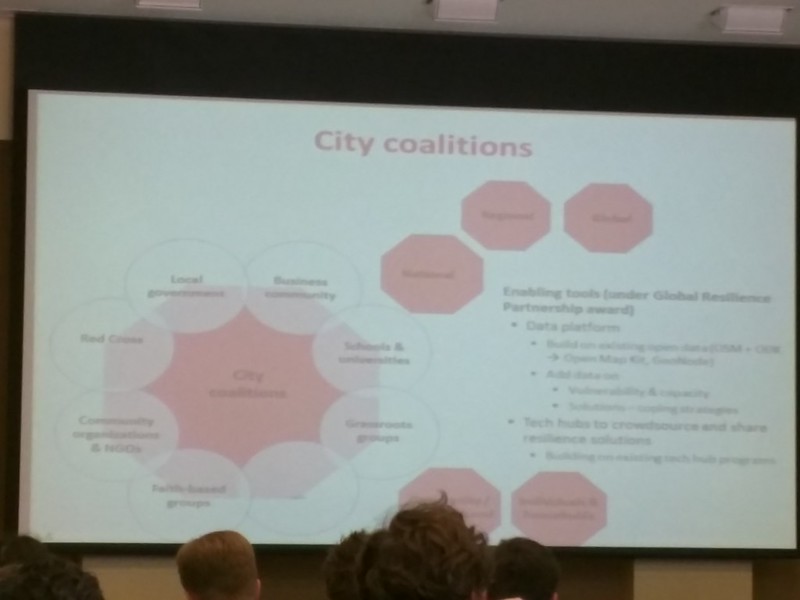
Disclaimer: The opinions expressed here are my own, and do not reflect those of my employer. -Fumi Yamazaki
Paul Mesarcik (Lumkani)
- Fire spreads quickly, houses are fragile to fire and extremely dense in those urban slums
- In March 2015 in Manila, just 2 fires made 10,000 families go homeless

Solution:
1. In-home heat detector
2. Transmission to neighbouring devices
3. Data collection through internet gateway
2007 - 1 billion people worldwide were affected
2020 - 1.4 billion people worldwide will be affected
Urban slums are one of the most underserved communities in the world.
Peer to Peer Communication for Resilience
Meena Palaniappan (Atma Connect)
- Connecting and empowering people for resilience
- People are not objects of development, we need to work together
- Poor people will suffer the most from climate changes- flooding, etc
- Social cohesion is key resilience tool (people are far more likely to survive disasters when they have good social networks and connections)
- Mobiles for people- build technology to help people solve their own problems.
- AtmaGo - a mobile web app to connect and help neighbors
- People in poor neighborhoods miss early warnings. Hyper local information sharing is important, with information such as flood is coming, road blocks, etc.
- AtmaGo is built on Facebook and Twitter, since that's what people in Jakarta use.

Data Mining to Increase Small Farmer Resilience & Agricultural Performance in Latin America
Everett Wetchler (Bayes Impact)
- Agriculture yields problem- focus on rice
- Growing global competition, climate change, FTA making farmers difficult
- Organizations in LatAm- many are funded internationally
- Big data in rice agriculture workshop - many talented agronomists, very few software engineers

Finding Data Invisibles: Addressing the Data Gap with Callboxes
Rose Shuman & Mita Paramita (QuestionBox)
- BrightFront Group
- National Ebola Hotline for UNICEF
- QuestionBox infrastructure is free public community for central hotline in local language
- Featured in World Economic Forum as data-driven development
- Community based reciprocity
- Putting QuestionBox in health clinics

3 Modes of resilience
1) direct linkages 2) self-sufficiency 3) short term infrastructure
Crowdsourcing Community Resilience Solutions in Dhaka
Ian O’Donnell (Red Cross)
- Safer, healthier and stronger communities
- Designing across Red Cross Red Crescent Network: 189 countries, 60k local branches, 17 million volunteers
- Engaging one billion people for safety and resilience by 2025
- Enabling local problem solving at scale
-RedCross, Governmental networks, academic and NGOs, business networks
- Making city coalitions
- Working with urban slum in Dhaka. Not a lot of information sharing
- Working with Open Streetmap, Tech Hubs, utilization of mobile data, working with World Bank, etc

Disclaimer: The opinions expressed here are my own, and do not reflect those of my employer. -Fumi Yamazaki
0 件のコメント:
コメントを投稿